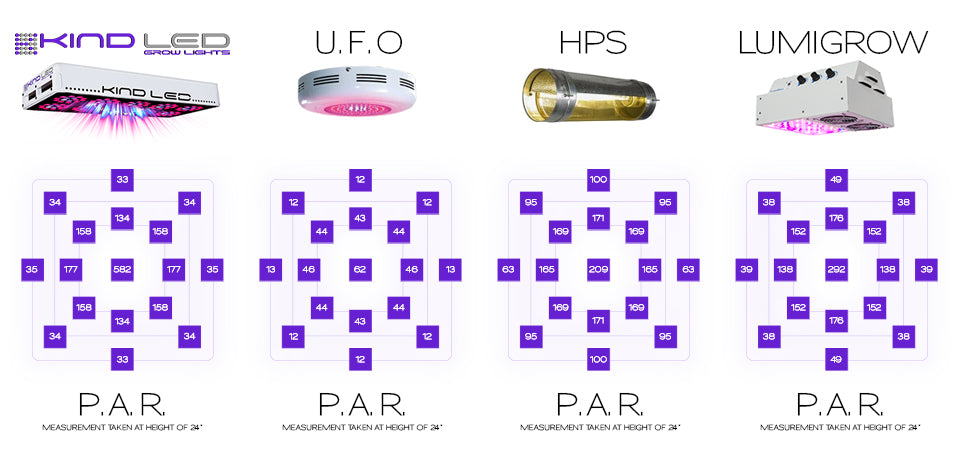Understanding Targeted Full Spectrum LED Grow Lights and PAR Readings

Full Spectrum LED Grow Lights and Par Reading
When it comes to measuring the amount of effective light an LED, HID, and fluorescent light fixture emits for a plant to use, there are two primary measurements that should be read and examined together.
First, PAR or Photosynthetic Active Radiation needs to be measured. PAR is essentially a measurement of light emission within the photosynthetic range of 400-700nm. This represents the area of light that plants use for photosynthesis, or to grow. PAR is measured by the amount of micro moles of light per square meter per second. Although PAR is a key measurement, it only tells one part of the story. There are many areas within the PAR scale which plants absorb only in small quantities, such as in the green range (560 nm). Thus, a reading of a light’s spectrum must be used in conjunction with the PAR reading to determine from what bandwidths those micromoles are being generated, and in what amounts. A spectrum reading is obtained by using a piece of equipment called a spectrometer. These two readings together will give a complete picture of a light’s effectiveness; PAR showing strength, and spectrum showing that this strength is in the proper wavelength proportion for what the plant can actually utilize, and not just wasted energy. These two measurement tools produce a reading that shows not only what wavelength or color is being emitted, but also the absorption value of that particular wavelength. By looking at this graph, one can determine if the light is emitting the proper wavelengths used by the plant for photosynthesis and at the correct absorption peaks required for robust and quality plant growth. HID lights are a classic example for why considering both of these readings is so important. These traditional lights have decent PAR readings, but when their spectrum is revealed, it becomes evident that they emit most of their energy in the wrong areas, making them an inefficient lighting option. Kind LED Grow Lights on the other hand, compared to HID lighting, as well as to other LED lighting options, show extremely high PAR readings with an efficient and accurate distribution of strength across your plants’ desired spectrum.

KIND LED Light Spectrum At 24 Inches
w/ Plant Absorption Percentage by Nano-meter Overlay

LED’s are supposed to target spectrum, so what’s up with the white LED’s??
Kind LED’s have been designed to have a full yet targeted spectrum for growth and/or flowering, and don’t waste any energy emitting large amounts of spectral ranges that plants don’t use high amounts of. We specifically target the areas with the highest absorption rates in order to deliver exactly what the plant needs for photosynthesis, and not a bunch of light the plant otherwise sees as useless.
Lately, there has been a wave of companies that are using all white LED’s in their design. These lights follow the more familiar color temperate range that we commonly know from HID and T-5 bulbs, 2700K-6500K. Although this makes a light that is closer to what we are all used to seeing as far as color, it negates one of the most important benefits of LED lights, not wasting energy on light the plant can’t readily absorb and use!
Some are touting that they have replicated the spectrum of the sun. That’s great and all, but the big difference between the sun and your grow light is that the sun has an endless supply of nuclear energy, so it’s not that concerned with expelling energy in those lesser used spectral ranges, plus those colors mixed together make the world a beautiful place. Your grow light and pocketbook on the other hand, would rather not waste unusable energy and your plants could care less if they aren’t seeing the world in real color. In fact, they’ll thank you for the purple world they grow in because they know that you’re doing your part to conserve for the planet, while giving them what they need to succeed.